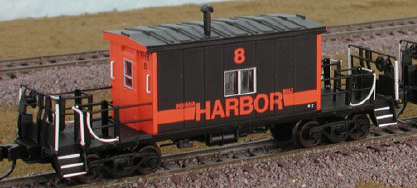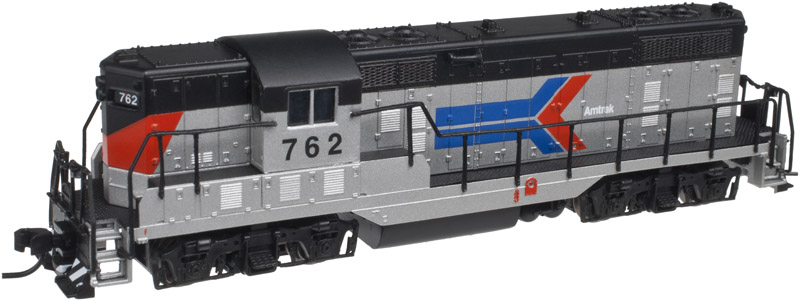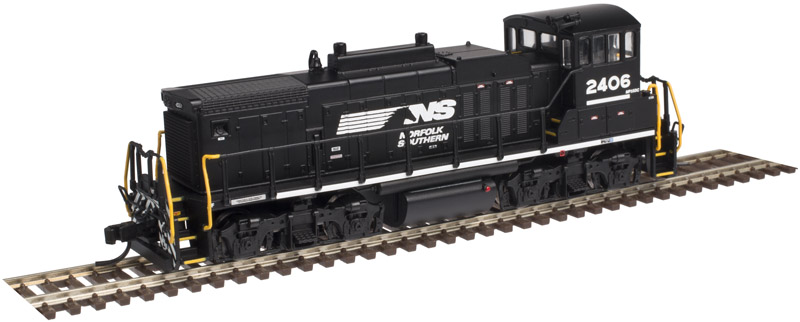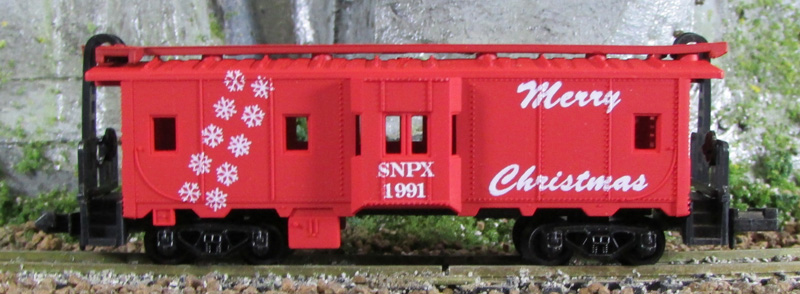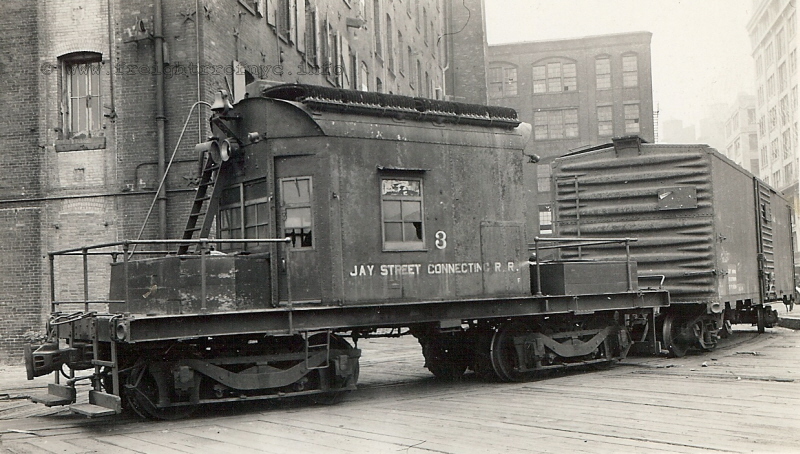Model Information: This model features: Fox Valley Metal wheels and
Wire grabs and cut levers.
This short body bay window caboose design was developed by International Car and MoPac in the 1970s. Several other railroads used very similar cars. These were assigned to road service and were NOT transfer cabooses.
This short body bay window caboose design was developed by International Car and MoPac in the 1970s. Several other railroads used very similar cars. These were assigned to road service and were NOT transfer cabooses.
Prototype History: A transfer caboose looks more like a flat car with a shed bolted to the middle of it than it does a standard caboose. It is used in transfer service between rail yards or short switching runs, and as such, lacks sleeping, cooking or restroom facilities. The ends of a transfer caboose are left open, with safety railings surrounding the area between the crew compartment and the end of the car.
A recent variation on the transfer caboose is the "pushing" or "shoving" platform. It can be any railcar where a brakeman can safely ride for some distance to help the engineer with visibility at the other end of the train. Flatcars and covered hoppers have been used for this purpose, but often the pushing platform is a caboose that has had its windows covered and welded shut and permanently locked doors. CSX uses former Louisville & Nashville short bay window cabooses and former Conrail waycars as pushing platforms.
From Wikipedia
A recent variation on the transfer caboose is the "pushing" or "shoving" platform. It can be any railcar where a brakeman can safely ride for some distance to help the engineer with visibility at the other end of the train. Flatcars and covered hoppers have been used for this purpose, but often the pushing platform is a caboose that has had its windows covered and welded shut and permanently locked doors. CSX uses former Louisville & Nashville short bay window cabooses and former Conrail waycars as pushing platforms.
From Wikipedia
Road Name History: The IHB is an independent railroad which is jointly owned by Conrail Shared Assets Operations (51%) and Canadian Pacific Railway (49%). These shareholders trace their ownership stake in IHB to previous mergers and acquisitions in the railroad industry. This came from Conrail, which had owned a 51% controlling interest. Conrail's ownership is traced back to the Penn Central Transportation Company and prior to that, the New York Central Railroad and Pennsylvania Railroad. Canadian Pacific's ownership is through its subsidiary, the Soo Line Railroad, which had inherited it from the Chicago, Milwaukee, St. Paul and Pacific Railroad.
The line comprises 320 miles (510 km) of track?30 miles of single mainline track, 24 miles (39 km) of double-main track and 266 miles (428 km) of additional yard and side track?starting northwest of Chicago in Franklin Park, Illinois, traveling southeast around the city to its headquarters in Hammond, Indiana.
The line's largest yard, [Blue Island] is located in Riverdale, Illinois with other yards in Burnham, Calumet City, Alsip, Argo, LaGrange, Rose and Franklin Park. In [Indiana] Whiting, Hammond, Michigan Ave, Lake Front in East Chicago. The Gibson Yard located in [Hammond], is arguably the largest auto-switching operation in the United States.
Throughout the 1970s and 1990s to the present, Indiana Harbor Belt operated an extensive interlocking tower system including: East End, Osbourne, Calumet, State Line, Gibson, Stewart Avenue, Graselli, 55th Street and Argo towers with switch tenders at North Harvey and Columbia Avenue in Hammond. They later took over State Line tower from the Chicago and Western Indiana Railroad.
From Wikipedia
The line comprises 320 miles (510 km) of track?30 miles of single mainline track, 24 miles (39 km) of double-main track and 266 miles (428 km) of additional yard and side track?starting northwest of Chicago in Franklin Park, Illinois, traveling southeast around the city to its headquarters in Hammond, Indiana.
The line's largest yard, [Blue Island] is located in Riverdale, Illinois with other yards in Burnham, Calumet City, Alsip, Argo, LaGrange, Rose and Franklin Park. In [Indiana] Whiting, Hammond, Michigan Ave, Lake Front in East Chicago. The Gibson Yard located in [Hammond], is arguably the largest auto-switching operation in the United States.
Throughout the 1970s and 1990s to the present, Indiana Harbor Belt operated an extensive interlocking tower system including: East End, Osbourne, Calumet, State Line, Gibson, Stewart Avenue, Graselli, 55th Street and Argo towers with switch tenders at North Harvey and Columbia Avenue in Hammond. They later took over State Line tower from the Chicago and Western Indiana Railroad.
From Wikipedia
Brand/Importer Information: Bluford Shops began in 2007 as a side project of two model railroad industry veterans, Craig Ross and Steve Rodgers. They saw a gap between road names available on N scale locomotives but not available on cabooses. They commissioned special runs of Atlas cabooses in Atlantic Coast Line, Central of Georgia, Monon, Boston & Maine and Southern plus runs on Grand Trunk Western and Central Vermont on the MDC wooden cabooses. While these were in process, they began to develop their first all new tooling project, 86' Auto Parts Boxcars in double door and quad door editions in N scale. By January of 2008, Bluford Shops became a full time venture. Along with additional N scale freight cars and their own tooling for new cabooses, they have brought their own caboose line to HO scale. They also have their popular Cornfields in both HO and N. The future looks bright as they continue to develop new products for your railroad.
The town of Bluford in southern Illinois featured a small yard on Illinois Central's Edgewood Cutoff (currently part of CN.) The yard included a roundhouse, concrete coaling tower (which still stands) and large ice house. Reefer trains running between the Gulf Coast and Chicago were re-iced in Bluford. Things are more quiet now in Bluford with the remaining tracks in the yard used to stage hoppers for mines to the south and store covered hoppers. Intersecting the IC line in Bluford is Southern Railway's (currently NS) line between Louisville and St. Louis. Traffic on this single track line remains relatively heavy.
The town of Bluford in southern Illinois featured a small yard on Illinois Central's Edgewood Cutoff (currently part of CN.) The yard included a roundhouse, concrete coaling tower (which still stands) and large ice house. Reefer trains running between the Gulf Coast and Chicago were re-iced in Bluford. Things are more quiet now in Bluford with the remaining tracks in the yard used to stage hoppers for mines to the south and store covered hoppers. Intersecting the IC line in Bluford is Southern Railway's (currently NS) line between Louisville and St. Louis. Traffic on this single track line remains relatively heavy.
Item created by: gdm on 2018-12-18 13:47:14. Last edited by CNW400 on 2020-05-20 14:50:53
If you see errors or missing data in this entry, please feel free to log in and edit it. Anyone with a Gmail account can log in instantly.
If you see errors or missing data in this entry, please feel free to log in and edit it. Anyone with a Gmail account can log in instantly.


